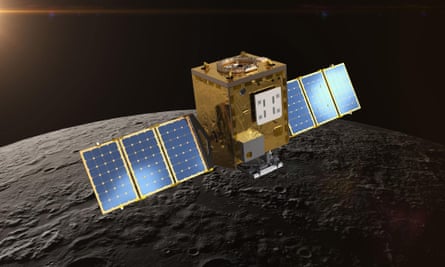Space engineers are set to launch an unusual mission this week when they send a probe built by UK and US researchers to the moon to map water on its surface. Lunar Trailblazer’s two year mission is scheduled to begin on Thursday when the probe is blasted into space from Florida on a Space X Falcon rocket.
Its goal – to seek out water on the lunar surface – may seem odd given that the moon has traditionally been viewed as an arid, desiccated world. However, scientists have recently uncovered strong hints that it possesses significant quantities of water. It will be the task of Lunar Trailblazer to reveal just how much water there is near the lunar surface and pinpoint its main locations.
The probe’s progress will be followed with keen interest by space engineers and astronomers who believe lunar water could play a key role in plans to set up staffed colonies on the moon. Using power provided by solar power plants, water could be turned into its constituent elements of hydrogen and oxygen. The former would then be used as fuel while the latter would allow astronauts to breathe.
“This is primarily a scientific mission,” said Prof Neil Bowles, leader of the Oxford University team of physicists who built one of Lunar Trailblazer’s main instruments. “However, it should also tell us how water is transported across the lunar surface and that has implications for future lunar exploration by humans.”

Until recently it had been assumed that water molecules brought to the moon by meteorites and comets would decompose quickly as sunlight broke them down into hydrogen and oxygen which would then have drifted into space. However, several robotic probes have recently found compelling evidence that water, mainly in the form of ice, exists in fairly large amounts in some deep, permanently shadowed craters, with the lunar south pole offering the most promising candidates.
These discoveries were taken even further by India’s Chandrayaan-1 probe that found, in 2009, that traces of water could been seen on the moon’s surface far away from the poles. “It was a big surprise that changed our perceptions of what we might find on the moon,” said Bowles.
However, the instrument on Chandrayaan-1 that made the discovery did not have the spectral range to fully map out water on the lunar surface and Lunar Trailblazer has been designed to get round that problem. It will carry two instruments. The first is an infrared scanner that will pinpoint water and other geological features. The second, designed by Bowles and his team, is a thermal mapper that is essentially a highly advanced heat camera.
Working in tandem, these instruments should then be able to create a water map of the lunar surface. “We know there is water at the moon’s poles but we are not sure how it ended up there,” said Bowles. “We think there is a kind of lunar water cycle just as there is one on Earth although in the case of the one on the moon it has nothing to do with clouds or rain.”
There are two main scenarios, he added. “Either water is delivered by comets or meteorites that hit the lunar surface and release lots of water which then condenses in cold traps at the poles. Alternatively very thin layers of water may be formed by reactions in the lunar soil.
“However, we do not know how that water would move around and build up into ice deposits. That is what we are trying to find out. We are interested in understanding why there is water on the moon and how it behaves there and that is important not just for our understanding of the moon but in appreciating what might be happening on other worlds that are similar to the moon, such as Mercury.”
after newsletter promotion
Lunar Trailblazer will not be the only spacecraft scheduled to be blasted into space on Thursday, however. The launch manifest also includes the rocket’s main mission, IM-2, a lunar lander built by the US company Intuitive Machines. It is destined to settle on to the moon where it will drill beneath the surface in a bid to find water there.
In addition to these craft, there will be a probe – named Odin by its builder AstroForge – that will fly to a very different destination: asteroid 2022 OB5. Odin will take images there in preparation for a return mission which is planned to land on the asteroid and begin mineral extraction on its surface.
These missions are all part of Nasa’s commercial lunar payload services programme which has been set up to encourage companies to send small robotic landers and rovers to the moon and other near Earth destinations. The main aim is to make preparations for the eventual colonisation of the moon.
Source: theguardian.com


